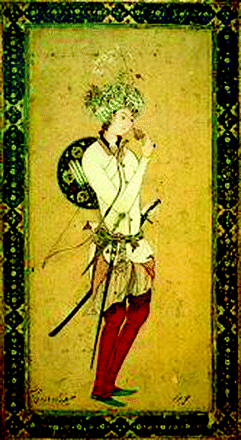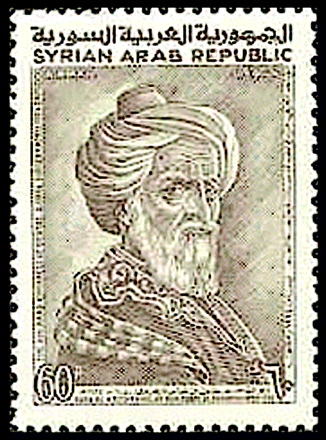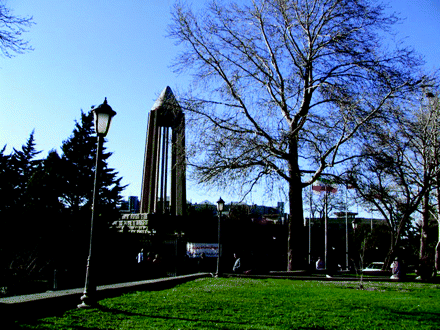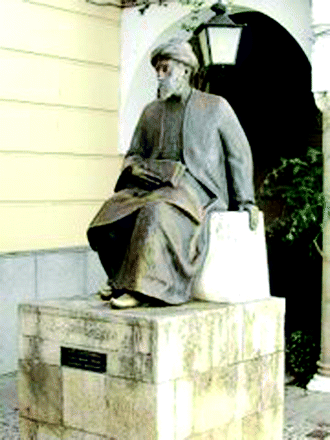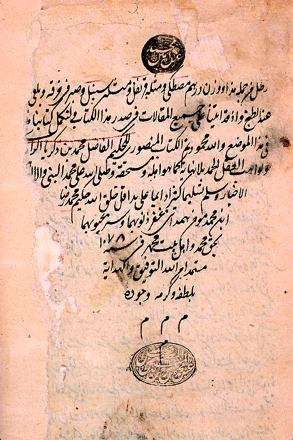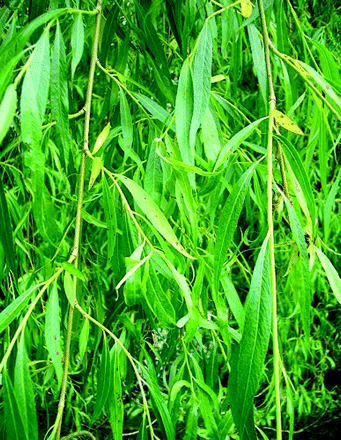Medicine in the Days of the Caliphs
- Stanley Scheindlin, DSc, holds a BS in pharmacy from Temple University and graduate degrees in pharmaceutical chemistry from Philadelphia College of Pharmacy and Science (now University of Sciences in Philadelphia). His academic research dealt with plant constituents and chemical interactions of vitamins. In his pharmaceutical industry career, he handled new drug formulation development, and later regulatory affairs, presiding over the filing of about 100 generic new drug applications and two innovative drug applications. Now retired, his activities include volunteer work, consulting, and writing Reflections pieces for this journal.
In our era, advances in medicine come at a dizzying pace. Since at least the 1950s, we have benefited from a stream of new drugs––natural substances and synthetic molecules, and more recently monoclonal antibodies and rDNA-origin proteins––and we look forward to more of these as well as gene therapy and stem cell–derived treatments. There have been major advances in diagnosis, largely through sophisticated instrumentation (e.g., CAT scans and MRI), and surgeons now operate freely in body areas formerly closed to them, such as the heart and the arteries. Almost every week the news media inform us of new developments or early-stage discoveries with seemingly unlimited potential.
As a respite from the excitement of our age, it may be instructive to reflect on an era marked less by an urge for progress than by a desire to preserve the heritage of the past. Such a feeling existed during the Middle Ages, specifically from the ninth century to the thirteenth century. The theater of significant medical and pharmaceutical activity at that time was not Europe, but the Mediterranean basin bordering Asia, Africa, and Europe. During that era, a number of outstanding medical people, and many more whose names have been lost, succeeded in preserving Greek and Roman medical knowledge while breaking some new ground in the fields of medicine and pharmacy.
Setting the Scene: Time and Place
As the ninth century opened, just seventy-five years after the birth of Islam on the Arabian peninsula, the Arabs had taken control of the Fertile Crescent (now Israel, Jordan, Lebanon, and Syria), Mesopotamia (now Iraq), Egypt, all of North Africa, and Spain. In their eastward expansion they came in contact with Indians and Chinese, learning from both peoples. Their knowledge of anatomy, for instance, is said to have been acquired from China. In the west they were joined by the Moors, North African Moslems of Berber origin, in conquering Spain.
Whereas most of Europe at this time was sunk in the Dark Ages, and sickness was deemed to be divine punishment, the Arab civilization was eager for learning and especially eager to absorb the legacies of ancient Greek and Roman science and philosophy. The major icons of classical medicine were the Greek physician Hippocrates (460?–380? BCE) and the Roman physician Galen (ca129–ca200 CE). In medical works attributed to him, Hippocrates taught that diseases had material causes and should not be treated by magic or witchcraft. He held that illness was caused by an imbalance in the four humors flowing from the liver: blood, black bile, yellow bile, and phlegm. He also believed in supporting the curative properties of the body before resorting to drugs or surgery (1).
Galen developed medical theories based on experiment and performed dissections on various animals. Unlike Hippocrates, he emphasized drug therapy, to such an extent that the various aromatic waters, spirits, tinctures, and other extracts prepared from plant drugs are called galenicals. Galen’s influence on medical practice persisted in Europe, thanks in large part to the translators and commentators of the Arabian era, into the nineteenth century (1).
What follows is a general overview of medicine and pharmacy from the ninth century to the thirteenth century, with emphasis on the contributions of the major Moslem and Jewish medical figures. The Arab-dominated part of the world enjoyed an era of tolerance and acceptance of other faiths and nationalities. In Spain, from the tenth century to the twelfth century there existed a period of Moslem–Jewish cooperation known as the “Golden Age.” The historian Sarton (2) notes that in the Mediterranean world, exchanges among the Moslem, Christian, and Jewish civilizations were most intense in the twelfth century. LaWall sums up this period by saying, “The Arabians preserve[d] the pharmaceutic art and carr[ied] the torch of professional and scientific knowledge from the sixth to the thirteenth centuries” (3).
Medicine and Pharmacy in Baghdad
By the eighth century, Baghdad had become a major city; its intellectual life enriched by Arab, Jewish, Indian, and Nestorian Christian scholars who settled there. Classical medical texts were translated into Arabic from the Greek and Syriac languages. Translation of Galen’s works made Baghdad a center of the revival of the humoral theory of medicine. In 805, the first hospital in the city was founded at the order of Haroun al-Rashid, Caliph of the Eastern Caliphate.
Another major innovation, spurred by the demand for complex prescription formulas, was the emergence of the pharmacist (i.e., apothecary) as a professional separate from the physician (3, 4). This development was ahead of its time as far as the West was concerned; in general, the separation of the two professions came much later. Thus, in the novels of Jane Austen (1775–1817), we find apothecaries (in England called surgeon-apothecaries) who examine and diagnose patients, then prepare medicine for them. The poet John Keats (1795–1821) was such a surgeon-apothecary. In the 1830s, Charles Dickens, in Pickwick Papers, created two comic characters of this profession. Even in twentieth-century America there were “dispensing doctors” who provided their patients with medicines from a limited stock which they kept in their offices. Yet back in ninth century Baghdad there were already licensed apothecary shops, inspected by government officials.
Although medical education and practice were still largely unregulated, an interesting event occurred during the reign of Caliph al-Muqtadir (908–932). In 931, a case of medical malpractice came to the caliph’s attention. He then issued an edict that anyone wishing to practice medicine in Baghdad must prove his competence to one Sinan ibn Thabit. This could be considered one of the earliest examining-licensing boards in history (5).
Contributions Made by Moslem Physicians
Rhazes (Abu Bakr al-Razi) (841?–925), a Persian by birth, became the director of the hospital in Baghdad. A philosopher and a physician, his writings cover a wide range of subjects. His Comprehensive Book on Medicine contains the earliest description of smallpox and measles. Notably, Rhazes recommended testing drugs on animals before giving them to people, and he introduced the use of opium to sedate patients prior to surgery (3, 4).
Tenth-century Cordova, in Spain, rivaled Baghdad in learning and scholarship. The most illustrious physician of Cordova was Albucasis (Abu Al-Qasim Al-Zahrawi) (936–1013). He authored an encyclopedic medical text, in thirty volumes, The Guide for Him who Cannot Compose (or Al-Tasrif, in its abbreviated Arabic title). As an uncritical follower of Galen, Albucasis helped to perpetuate Galen’s theories, for better or for worse.
An independent pharmacy profession did not develop in Spain as it had in Baghdad; thus, physicians had to compound their own medicines. Indeed, Albucasis devoted the twenty-eighth volume of his text to pharmacy. This volume is divided into three parts, whereby the first teaches how to obtain, store, grind, and oxidize or reduce minerals. In this respect, Albucasis departs from Galen, who did not include minerals in his materia medica. In fact, Albucasis’s use of mineral drugs is thought to have stemmed from his knowledge of Indian medicine. The second part of the volume covers plant drugs and includes many familiar today, such as acacia, cardamom, licorice, mandrake, opium, squill, and wormwood. It also covers dosage forms made from botanicals, including oils, vinegars, and aromatic waters. The third part discusses drugs of animal origin (4).
Other volumes of Albucasis’s tome also deal with drug therapy. Volume twenty-nine contains multi-lingual lists of drug names and synonyms; volume four gives the eighty-four–ingredient composition of the antidote known as the Great Theriac; volume six discusses irritant purgatives; and volume twelve covers remedies for both obesity and underweight, over- or under-secretion of milk, and aphrodisiacs (4).
The physician-philosopher of this period with the most enduring impact was Avicenna (Ibn Sina) (980–1037). Hailing, like Rhazes, from Persia, he was a polymath and a prodigy. He began to practice medicine while in his teens; it is said that at age sixteen he was supervising older doctors (6). He led a hectic life. Princes consulted him on political as well as medical matters, which led to his involvement in court intrigues. Several times he fled and went into hiding; once he was imprisoned, escaped, and took sanctuary with a friendly apothecary. He enjoyed fourteen years of relative peace at the court of Isfahan, Persia. Through it all he kept on writing: while on horseback, while in prison, in all circumstances (6).
Avicenna’s landmark medical work was the million-word Kitab al-Qanun fi l-tibb, known in the West as the Canon of Avicenna. The Canon made the doctrines of Hippocrates and Galen (and later writers) accessible, and constituted a summary of the medical knowledge of Avicenna’s time. Avicenna classified drugs, in line with the humoral theory, into four categories: warmers, coolers, purges, and sudorifics (sweat-producers). Body heat was to be regulated by blood-letting, diet, baths, exercise and massage. He recognized the relation of such mental symptoms as anxiety and depression to physical factors, foreshadowing psychosomatic medicine. A keen observer and diagnostician, he reported certain symptom-disease associations, such as, swelling of the groin with a septic leg, and clubbing of the fingers with “ulceration” of the lungs (probably owing to any number of lung conditions resulting in hypoxia). He is believed to have been the first to describe meningitis (5) and to note the sweet taste of the urine of diabetics (3).
Avicenna’s Canon remained influential for 600 years, and was a standard textbook in European medical schools until the seventeenth century. Helping to keep it alive were commentaries written by Ibn al-Nafis, Maimonides, and others. In medieval thinking, medicine was an unchanging body of truth. Because Avicenna had collected nearly everything said about medicine by the Greek and Arab physicians, any new research or investigation was deemed unnecessary (5).
Relatively unknown, but undeservedly so, is Ibn al-Nafis (?–1288). Born in or near Damascus, he made his career in Cairo, where he held the posts of chief physician of Egypt and personal physician to Sultan Baybars I. He grew rich and lived luxuriously in Cairo. It would seem that he had no family, for he willed his house, fortune, and books to the newly-opened (1284) Mansuri hospital in Cairo (7). Of his practice, it was said that “he did not prescribe a remedy as long as he could prescribe a diet, and did not prescribe a compound remedy as long as he could content himself with a simple drug” (7).
Al-Nafis’s most important medical work was his commentary on Avicenna’s Canon. In this work, he collected the passages on anatomy from the first three sections of the Canon and commented on them as a unit. Here, in a remarkable tour de force, Al-Nafis correctly described the pulmonary circulation of the blood, centuries before William Harvey. An English translation from his Arabic manuscript reads as follows:
The blood from the right chamber of the heart must arrive at the left chamber, but there is no direct pathway between them.
The thick septum of the heart is not perforated and does not have visible pores, as some people thought, or invisible pores,
as Galen thought. The blood from the right chamber must flow through the vena arteriosa [pulmonary artery] to the lungs, spread
through its substance, be mingled with air, pass through the arteria venosa [pulmonary vein] to reach the left chamber of
the heart....(8).
Remarkably, also, al-Nafis arrived at his theory by means of abstract reasoning, without doing experimental work. So unorthodox was this theory that later Arab physicians totally ignored it––except for one commentator who agreed and another who defended Avicenna by criticizing al-Nafis (7). In Europe, two authors, Michael Servetus in 1553, and Realdo Colombo in 1559, set forth the same idea in terms reminiscent of al-Nafis’s (7). Whether these men could have known of al-Nafis’s writing has been a matter of debate among scholars (9).
Contributions Made by Jewish Physicians
Asaph Judaeus, also called Asaph Ha-Rofe (Asaph the Physician), of ninth-century Mesopotamia, wrote the earliest treatise on medicine in Hebrew, titled Sefer Asaph (Book of Asaph) or Sefer Refu’ot (Book of Medicines). His work covers the structure of the human body, nutrition, antidotes, prescriptions, and information on 123 medicinal herbs. In one chapter he urges his pupils to provide treatment and medicine to the poor without charge. Asaph’s writings remained popular until the twelfth century (10). The following quotation from Sefer Asaph might put Asaph in the same category as al-Nafis: “The pulsations of the blood vessels...originate from the heart, travel to the furthest extremities of the body, from which they return to the heart...” (11).
A probable contemporary of Asaph was the physician Isaac ben Solomon Israeli, an Egyptian Jew, known in Europe as Isaac Judaeus. His medical works reached Europe when Constantinus Africanus translated them into Latin under the title De Gradibus Simplicium. Isaac thus exerted influence on medieval Western medicine (10).
Outside the main sphere of Arab influence was Italian-born Shabbatai ben Abraham ben Joel (913–ca982), better known as Donnolo. Appointed as personal physician to the Byzantine viceroy Eupioxias, Donnolo became one of the first European medical authors outside of Spain. He acquired and studied Greek and Latin medical manuscripts, and was familiar with the writings of Asaph Judaeus. Donnolo, however, seems to have been less acquainted with Arabic medicine. His books are based mainly on his experience in forty years of medical practice. His Sefer Ha-Mirkahot (Book of Compounded Remedies) was the first Hebrew-language medical work written in Europe. He also wrote an Antidotarium based on Arabic sources and a treatise on fevers. All three of Donnolo’s books were combined under the title Sefer Hayaqar (The Precious Book). Though highly regarded in his time, Donnolo was largely overshadowed by Avicenna and Maimonides (10, 12).
The greatest Jewish physician of the era was Moses Maimonides (1135–1204). Rabbi Moses ben Maimon, widely known by his Greek patronymic Maimonides, and in Jewish circles by the acronym Rambam, was a giant in philosophy and religion, as well as in medicine. He undertook to distill the vast body of Talmudic writings into a single book classifying and codifying all Biblical and Talmudic laws (the Mishnah Torah). He attempted also, in his Guide for the Perplexed, to show that Aristotelian philosophy was compatible with Jewish religious tradition. The latter book also influenced Christian theologians, such as Thomas Aquinas and Albertus Magnus. In his lifetime, Maimonides was the chief rabbinic authority of the Jewish world, albeit not without controversy, and 900 years later his religious writings are still being studied.
Maimonides was born in Cordova, the capital of the Western Caliphate, just as the “Golden Age” of Jewish-Moslem coexistence was fading. The Almohads, a fanatical Islamist sect from Morocco, had overspread Spain, outlawing both Judaism and Christianity. Forced to choose between converting to Islam or leaving Spain, Maimonides left, traveling through North Africa and the Near East before settling in Egypt. He received medical training first from his physician father, then more formally while living in Fez. Thus, he was able to earn his living as a physician (10, 13).
In Egypt, he became renowned for his professional ability, and ultimately was appointed personal physician to Saladin, his harem, and his children––a post he held for twenty years. During this period Maimonides resided in Fostat, while Saladin’s palace was in Cairo, two to three kilometers away. In a letter which has been preserved, he describes his typical workday: attending the royal family all morning, then returning home to find the waiting room full of patients––Jews and Gentiles, nobles, and common people. He asks their indulgence while he eats a quick meal, then sees patients till well into the evening (14). This is reminiscent of the life of a conscientious American doctor before the advent of group practices and physicians’ answering services.
In caring for patients, Maimonides took a rational, conservative approach. Like Hippocrates, he held that Nature cures most ills, and that lifestyle changes should be tried before resorting to medications. Thus he wrote: “Among a thousand people only one dies a natural death—-most succumb to irrational modes of living” (10). He recommended that one should avoid over-eating, over-exertion, and overindulgence in sex. He also believed firmly in the value of exercise for both young and old (14).
His ten medical works, all written in Arabic, include a compendium of Galen’s works and a commentary on the aphorisms of Hippocrates; the rest are original contributions. He wrote a treatise on drugs and one on poisons and antidotes. In the latter, he distinguished among the various kinds of snake venoms. For snakebite he used cautery, local tourniquets, rest, and treatment for shock. Several of his books, those on specific ailments, were written at the request of sultans and other nobles, including treatises on hemorrhoids; on hygiene, for a sultan suffering from attacks of depression; on asthma; and on coitus, for a sultan who may have been having difficulty satisfying his harem (13).
The “Oath and Prayer of Maimonides,” an inspirational pledge for health professionals, though composed in the late eighteenth century by a German-Jewish physician, seems aptly attributed to Maimonides because of its deeply religious and ethical tone (15).
Medicine in the Age of the Caliphs
The founding of hospitals has been mentioned above, as well as the emergence of pharmacy as a separate profession. The latter occurred in the East in the ninth century. The first definite record of a separation in Europe was a decree by the German Emperor Frederick in 1240 (15). Between the ninth and thirteenth centuries, specialties were already developing, with ophthalmology one of the first medical specialties (5). There were oculists, who practiced general ophthalmology and treated trachoma (“ramad” in Arabic), a disease endemic in Western Asia and Northern Africa. There were also lesser practitioners, called cataract “couchers”a. Literature appeared on embryology, obstetrics, and pediatrics; these works drew largely on Hippocrates, Galen, and Aristotle. One is cited which stresses the importance of breast-feeding, and the need for a healthy wet-nurse when there is insufficient mother’s milk (5).
Some medical texts were written in question and answer “catechism” format, for the training of students and as an aid to young physicians. One such work is dated from 1193. There were books on medical ethics, including doctor–patient relationships and doctor–doctor etiquette. Thus, Ali al-Tabari wrote that a physician should be kind and compassionate to his patients, not too talkative, and free of extravagant claims; he should not seek to benefit from another doctor’s faults, nor belittle another doctor (5). Another writer decried physicians who “...butter up the sultan with electuariesb...select pretty women as good for one’s health...and incite sexual desire...[to] attain access to people of wealth and authority.” A letter has been preserved in which a doctor tells his wife how hard it is to build up a practice where he resides because of the fierce competition. Another letter tells of mercenary physicians, and how some will attend only upper-class patients, leaving the common people to find other doctors (5).
Other criticisms of medical practitioners were also voiced. Abdun ibn Butlan (ca1060), in his book The Physicians’ Dinner Party, condemns those who seek to make money by owning a share in a pharmacist’s shop or dealing in shrouds! He attacks physicians for greed, incompetence, and hubris; but warns the public against therapeutic nihilism, and against faith healing and naturopathy (5). The physician might also be the target of wit and satire. As one brief example, the following verses, dating from 857, may be cited (5):
The physician, with his physic and drugs Cannot avert a summons that hath come
There died alike he who administered the drug, and he who took the drug And he who...sold the drug, and he who bought it.
In pharmacy, the Arabic tradition was generally practical, rational, and devoid of witchcraft. Mohammed the Prophet is said to have stated: “For every disease there is a remedy,” implying perhaps that it is the physician’s task to discover the right drug (5). The Prophet’s aphorism brings to mind the Jewish folk saying “God creates the remedy before the disease.” In the epoch discussed in this essay, the Arabs actively pursued the search for plant remedies, and books on pharmacy were written. Ibn al-Baytar (d1248) produced an encyclopedic work on botany and materia medica, describing some 1400 animal, vegetable, and mineral drugs. One noteworthy example is the use of an infusion of willow leaves to relieve joint pain––a precursor of the salicylates and aspirin. Other remedies confirmed by modern experience include male fern for worms, and elm bark for skin diseases (5). Male fern (Aspidium felixmas) and its ether-soluble oleoresin were recommended against human and veterinary tapeworm as late as the 1950s. Elm bark contains a water-dispersible mucilaginous substance which may exert a soothing and protective effect. In modern times it has been used in throat lozenges and applied as a poultice for suppurative inflammations. Although the people of this era lacked the potent receptor-targeting drugs we have today, the above three examples of leaves, fern, and bark show that they were not helpless in the face of disease. Bringing to bear knowledge gained from ancient authorities, as well as their own experience and skillful compounding techniques, they made the most effective use of the medicinal herbs available to them.
Despite the excessive reliance on ancient authorities, and the absence of scientific experiment as we know it, medicine and pharmacy in the Middle Ages were hardly stagnant. The information presented above on medical luminaries, practice, specialties, and satire, depicts a living, active profession. Finally, just as the physicians of this era had translated ancient Greek and Latin medical treatises into Arabic, their own works were later translated into Latin. Notable among the translators was Gerardo de Cremona, working at cosmopolitan Toledo in the late twelfth century (4). The demand for such translations far exceeded the supply until the invention of printing by Gutenberg in the mid-fifteenth century (4). At that point, the mingled medical legacy of Greece, Rome, and the medieval Arabic world was bequeathed to Renaissance Europe.
Acknowledgments
I wish to thank Raymond Scheindlin, PhD, Professor of Medieval Hebrew Literature at the Jewish Theological Seminary, New York, for his invaluable help in accessing literature pertinent to this article.
Footnotes
- © American Society for Pharmacology and Experimental Theraputics 2007
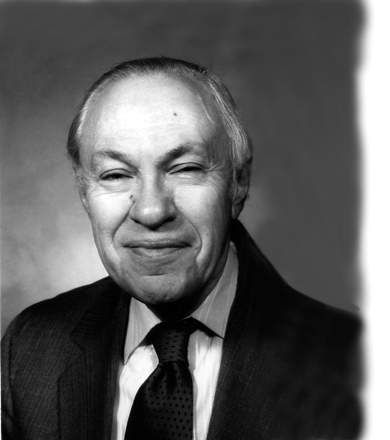
Stanley Scheindlin, DSc, holds a BS in pharmacy from Temple University and graduate degrees in pharmaceutical chemistry from Philadelphia College of Pharmacy and Science (now University of Sciences in Philadelphia). His academic research dealt with plant constituents and chemical interactions of vitamins. In his pharmaceutical industry career, he handled new drug formulation development, and later regulatory affairs, presiding over the filing of about 100 generic new drug applications and two innovative drug applications. Now retired, his activities include volunteer work, consulting, and writing Reflections pieces for this journal.

